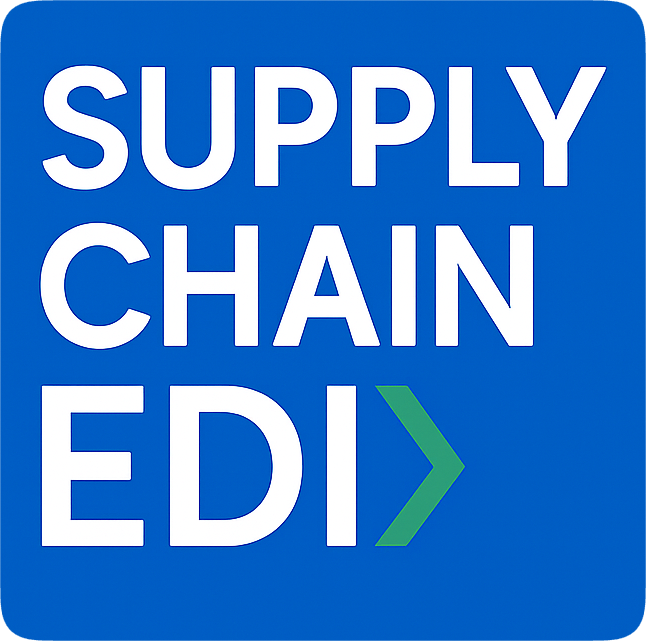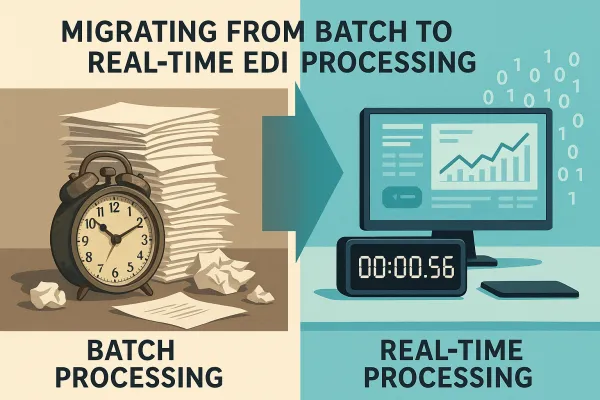The Complete EDI Cloud Migration Security Framework: Protecting Supply Chain Data During the Critical Transition Phase in 2025

Organizations now see 1,925 cyberattacks per week—that's a 47% jump from 2024. Ransomware incidents surged by 126% in Q1 2025 alone, with North America taking the biggest hit at 62% of all attacks. For supply chain professionals managing EDI cloud migrations, these statistics aren't just numbers—they represent the harsh reality of today's threat landscape.
By 2025, 99% of the infrequent cloud security breaches will be due to customer error, not the system itself. This Gartner prediction reveals a critical truth: Cloud migrations are riddled with hidden security risks. It's either data exposure during transfer or misconfigured infrastructure. Your EDI systems, which handle sensitive procurement data, financial transactions, and partner information, become prime targets during these vulnerable transition periods.
Supply chain disruptions cost large organizations an average of $182 million in lost revenue per company every year. These disruptions are spread across multiple event types, including Finance, Operations, geopolitical events, cyberattacks, and ESG issues. For EDI managers overseeing cloud migrations, security isn't just about compliance—it's about protecting the financial backbone of supply chain operations.
The 7 Critical Security Vulnerabilities in EDI Cloud Migrations
EDI cloud migrations face unique security challenges that differ from standard enterprise migrations. Your data is "exposed" during the migration process and security controls in the cloud may not match the previous environment. RBAC designed by the cloud provider may be significantly different and lead to a violation of best practices where someone can get access to files that they shouldn't.
The cloud migration process, especially across public networks, can expose sensitive information. Cloud misconfigurations remain a top cause of cloud migration security challenges. These aren't abstract concerns—they're documented failure points that have cost companies millions.
Here are the seven vulnerability areas that consistently compromise EDI migrations:
Data Exposure During Transit: Migrating large volumes of data from on-premises systems to the cloud can be complex and prone to errors. Ensuring data integrity and minimal disruption during the migration process is challenging. EDI data often includes purchase orders, invoices, and shipping manifests containing sensitive partner information.
Identity and Access Management Failures: Organizations have to be sure to implement strict Identity and Access Management (IAM) controls. Otherwise, users may gain unintended access to sensitive resources and poor data security. This increases the risk of insider threats and privilege escalation attacks. Legacy EDI systems often use shared credentials that don't translate well to cloud environments.
Third-Party Vendor Assessment Gaps: Modern TMS solutions like Cargoson, along with MercuryGate and Oracle TM, each have different security architectures. The breach was linked to a third-party supplier's system, not TalkTalk's own infrastructure. Many security incidents trace back to inadequate vendor security assessments.
Legacy System Integration Weaknesses: Check whether your legacy system meets the current compliance and security requirements. Modern EDI solutions often come with built-in compliance for standards such as HIPAA, GDPR or PCI-DSS, whereas legacy systems might lag in these areas.
Compliance Framework Misalignment: Cloud migration services can inadvertently introduce compliance violations. As an example, you might move protected health information (PHI). But you forget to ensure HIPAA compliance. This could lead to regulatory fines and legal consequences.
Network Segmentation Failures: The root cause was a simple configuration error. Capital One failed to restrict access properly, leaving sensitive cloud storage vulnerable. There were no enforced VPN requirements, no static IP allowlisting, and no real-time access monitoring in place at the time of the breach.
Backup and Recovery Vulnerabilities: 32% of cloud assets sit unmonitored, and each asset carries around 115 known vulnerabilities. EDI systems require continuous operations, making backup security during migration particularly challenging.
Pre-Migration Security Assessment: The Foundation Framework
Security planning begins long before you touch your first EDI transaction set. Before migrating, organizations should perform a comprehensive inventory of their digital assets. From there, you should map out dependencies to recognize any potential security threat. This means identifying data sensitivity levels, compliance requirements, and business-critical workloads.
Data Classification and Sensitivity Mapping
Start by categorizing your EDI data flows. Purchase orders containing competitive pricing information require different protection levels than basic shipping confirmations. Risk assessments should prioritize which workloads to migrate first. They should then flag any that require enhanced controls or need to remain on-prem for regulatory reasons.
Document every data type: financial EDI transactions (invoices, payments), operational data (inventory levels, shipping schedules), and partner-specific information (contracts, pricing agreements). Map these against sensitivity levels and regulatory requirements.
Current System Security Audit
Conduct penetration testing on your existing EDI infrastructure before migration planning begins. Testing the infrastructure for data leakage and access control issues is critical. This establishes your current security baseline and identifies gaps that cloud migration could exploit.
Review your current authentication mechanisms, encryption standards, and access logging. Many organizations discover their legacy EDI systems lack proper audit trails—a gap that becomes magnified in cloud environments where compliance demands detailed tracking.
Vendor Security Certification Requirements
When evaluating cloud EDI providers, demand SOC 2 Type II reports and ISO 27001 certifications. Organizations should implement robust access controls, encryption, and cloud compliance practices. Evaluating the cloud provider's security protocols, data protection policies, and breach notification procedures should be non-negotiable.
Leading TMS providers like Cargoson, MercuryGate, and Oracle TM maintain these certifications, but verify the specific coverage areas. Some certifications may not include EDI-specific transaction processing or partner data handling requirements.
Risk Scoring Methodology
Develop a quantitative risk assessment framework that weights both likelihood and impact. 83% of organizations dealt with at least one cloud security incident in 2024, and companies face an average of 2,300 cyberattacks every week. Use these baseline statistics to calibrate your risk models.
Score risks across multiple dimensions: data sensitivity (1-5 scale), regulatory impact (financial penalties), operational disruption (downtime costs), and partner relationship damage. This creates a defensible framework for migration prioritization and security investment decisions.
The Secure Migration Architecture: Technical Implementation
Building security into your EDI cloud migration requires specific technical controls that address the unique challenges of B2B data exchange. For this reason, you've got to embed security throughout the migration lifecycle. You just can't tack it on afterward.
End-to-End Encryption Protocols
Implement AES-256 encryption for data at rest and TLS 1.3 for data in transit. EDI uses a combination of authentication and encryption to control who can access certain files. The electronic system is much more secure than traditional paper-first methods. But cloud environments require additional encryption layers.
Use envelope encryption for EDI transaction files, where data keys encrypt your actual EDI documents, and master keys (managed by the cloud provider's key management service) encrypt the data keys. This provides both security and operational flexibility during partner onboarding.
Zero-Trust Network Architecture
Configuration also includes setting up the VPNs, firewalls, or AS2 connections that you need to ensure a secure data transfer pathway. But cloud EDI requires more sophisticated network segmentation than traditional VPN connections.
Implement microsegmentation where each EDI trading partner connection operates in its own network zone. Use software-defined perimeters (SDP) that verify device identity, user identity, and application authorization before allowing EDI data access. This prevents lateral movement if one partner connection becomes compromised.
Multi-Factor Authentication and Role-Based Access
Implementing Multi-Factor Authorization (MFA) is one of the easiest and cheapest ways to add an extra layer to security. As a result, it has become a standard. But EDI systems often involve automated processes that complicate traditional MFA implementation.
Use certificate-based authentication for automated EDI processes combined with hardware security modules (HSMs) for certificate management. For human access, implement risk-based authentication that considers location, device, and time-of-access patterns.
API Security for Modern EDI-TMS Integrations
APIs are "a critical part of modern mobile, SaaS, and web applications and can be found in customer-facing, partner-facing, and internal applications," as stated in the recently published OWASP API Top 10. It is important to test APIs for common vulnerabilities like broken authentication mechanisms or excessive data exposure. An API breach can be near devastating with the right conditions.
When integrating with TMS providers like Cargoson or other cloud-based logistics platforms, implement API rate limiting, OAuth 2.0 with PKCE for authorization, and JSON Web Token (JWT) validation. Use API gateways that provide traffic analytics and anomaly detection specifically tuned for EDI transaction patterns.
Monitoring and Logging Framework
Deploy security information and event management (SIEM) solutions that understand EDI transaction patterns. The average time to detect a cloud breach is still 277 days, which gives attackers plenty of time to cause damage. EDI systems need faster detection because transaction data has immediate financial impact.
Configure alerts for unusual partner access patterns, transaction volume anomalies, and failed authentication attempts. Log every EDI transaction with immutable timestamps and digital signatures for compliance and forensic analysis.
Compliance and Regulatory Considerations During Migration
EDI cloud migrations must maintain compliance across multiple regulatory frameworks simultaneously. Financial institutions must adhere to stringent regulations, such as GDPR, SOX, and PCI DSS. Make sure that new EDI systems meet these requirements. The challenge intensifies when your supply chain spans multiple jurisdictions.
GDPR Compliance Throughout Migration
European supply chain partners require GDPR compliance for any personal data contained in EDI transactions. This includes employee information in shipping documents, customer details in order confirmations, and contact information in partner directories.
Implement data minimization principles where EDI transactions contain only the minimum necessary personal data. Use pseudonymization techniques for employee identifiers and implement automated data retention policies that purge personal data according to GDPR timelines. Document data processing activities in detailed records of processing activities (ROPAs) that cover both pre-migration and post-migration data flows.
Healthcare EDI HIPAA Requirements
Healthcare supply chains handling medical devices, pharmaceuticals, or patient care supplies must maintain HIPAA compliance during EDI migrations. As an example, you might move protected health information (PHI). But you forget to ensure HIPAA compliance.
Use business associate agreements (BAAs) with cloud providers that explicitly cover EDI transaction processing. Implement administrative, physical, and technical safeguards that meet HIPAA Security Rule requirements. This includes unique user identification, automatic logoff, and encryption of PHI in EDI transactions.
Industry-Specific Frameworks
Automotive EDI requires compliance with TISAX (Trusted Information Security Assessment Exchange) standards. Manufacturers are required to follow specific legal standards when transporting goods. These standards are often stringent for manufacturers handling food, beverages, and pharmaceuticals. Violating these legal requirements can lead to heavy fines and penalties.
Manufacturing supply chains must address multiple regulatory requirements: FDA regulations for food and drug manufacturing, CPSIA for consumer products, and industry-specific standards like AS9100 for aerospace. Document how your cloud EDI solution maintains traceability requirements that these frameworks demand.
Cross-Border Data Transfer Considerations
International supply chains face complex data residency requirements. Teams should require providers to disclose the locations of all data centers, local data protection, and breach disclosure requirements. Some countries prohibit certain EDI data types from leaving their borders.
Implement data localization controls where EDI data remains within specific geographic regions. Use Standard Contractual Clauses (SCCs) for international data transfers and consider adequacy decisions when planning cloud provider selection. For sensitive supply chains, implement data sovereignty controls where encryption keys remain under your organization's control regardless of data location.
Vendor Security Due Diligence: The Critical Evaluation Process
Selecting secure EDI cloud providers requires systematic security assessment beyond basic feature comparisons. Considering all the risks associated with cloud computing before making the move can prevent security breaches later. These breaches are not only expensive in terms of the remediation costs involved but can also severely damage an organization's reputation.
Security Certification Verification
Demand current SOC 2 Type II reports, ISO 27001 certificates, and industry-specific certifications. But verify the scope of these certifications carefully. What's written in fine print is that while cloud providers do maintain many security certifications (i.e. Microsoft Azure), a large number of security roles and responsibilities will continue to fall on your team.
Review the actual audit reports, not just certification summaries. Look for any exceptions or management responses that indicate security gaps. For TMS integrations with providers like Cargoson, MercuryGate, or Oracle TM, verify that certifications cover the specific APIs and data flows your EDI systems will use.
Third-Party Risk Assessment Methodology
Develop standardized security questionnaires that cover EDI-specific requirements: encryption standards for transaction data, partner access controls, incident response procedures, and compliance monitoring capabilities. A recent Verizon Data Breach Investigations Report found that "20 percent of all cybersecurity incidents and nearly 15 percent of all data breaches" involved insider and privilege misuse patterns.
Implement continuous vendor monitoring rather than annual assessments. Use security rating services that provide ongoing risk scores based on external threat intelligence, vulnerability disclosures, and security incidents. This approach caught issues like Security researchers reported that patches for earlier Cleo vulnerabilities failed to fully block exploitation. In December 2024, a second flaw (CVE 2024 55956) was identified, allowing unauthorized users to run arbitrary PowerShell or bash commands. Arctic Wolf researchers also observed attempts to install Java based backdoors in Cleo MFT products. Clop later claimed responsibility for part of the ransomware activity against Cleo users.
Contractual Security Requirements
Include specific security requirements in cloud provider contracts: data encryption standards, incident notification timelines (typically 24-72 hours for EDI systems), security monitoring requirements, and compliance reporting obligations.
Negotiate clear liability terms for security breaches that differentiate between provider negligence and customer configuration errors. According to Gartner, through 2023, at least 99% of cloud security failures will be the customer's fault, mainly in the form of cloud resource misconfiguration. But vendors should still bear responsibility for their platform vulnerabilities.
Incident Response Integration
Verify that cloud providers can integrate with your incident response procedures. Establishing and practicing an incident response plan for privileged account takeovers will help mitigate damage from a breach. EDI systems require coordinated response that considers partner notification requirements and transaction processing continuity.
Test incident response integration during pilot migrations. Simulate security incidents to verify communication channels, escalation procedures, and technical response capabilities. Document response times and improvement areas for production deployment.
Post-Migration Security Monitoring and Optimization
Security monitoring for cloud EDI systems requires specialized approaches that account for transaction patterns, partner access behaviors, and regulatory requirements. Post-migration, ongoing compliance checks, access audits, and integrity verification are critical.
Continuous Security Monitoring Implementation
Deploy SIEM solutions with EDI-specific detection rules that identify unusual transaction patterns, unauthorized partner access attempts, and data exfiltration indicators. Cloud attacks happen constantly. In Q1 2025, organizations faced 1,925 attacks per week—that breaks down to about 275 attacks every single day. Your monitoring must match this threat velocity.
Use machine learning models that establish baselines for normal EDI behavior: typical transaction volumes by partner, standard processing times, and expected data patterns. Configure alerts for deviations that could indicate compromise or system problems.
Implement user and entity behavior analytics (UEBA) that tracks not just human access but also automated EDI processes. Suspicious patterns might include unusual data access by service accounts, unexpected partner connection attempts, or abnormal transaction processing times.
Performance vs. Security Optimization
Balance security controls with EDI processing performance requirements. The right transportation management system can help by providing real-time tracking, data-driven insights, and proactive risk management. Real-time tracking helps manufacturers monitor the exact locations of their shipments. This data allows them to access the current status and anticipated arrival times. The enhanced visibility helps spot delays before they become disruptive, supporting efficient production schedules and preventing downtime.
Use performance monitoring that correlates security control effectiveness with transaction processing latency. If encryption processes introduce unacceptable delays, consider hardware security modules (HSMs) or optimize cipher suites for EDI transaction patterns.
Regular Security Assessment Schedules
Conduct quarterly vulnerability assessments and annual penetration testing specifically designed for cloud EDI environments. Traditional pentesting worked for testing a small number of on-premise solutions once a year, but companies now have to evolve to continuous testing to keep up with cloud assets. You should look for cloud security testing that includes benefits like: Continuous testing to identify weaknesses and potential data exposure in critical assets before adversaries
Include partner notification in security testing schedules. Some EDI partners require advance notification of security testing that might affect transaction processing. Plan assessments during low-volume periods and coordinate with major trading partners.
Security Training and Awareness Programs
Develop EDI-specific security training that addresses cloud environment risks. Train employees on the new EDI system to maximize adoption and efficiency. But training must also cover security responsibilities in cloud environments.
Cover topics like recognizing phishing attacks targeting EDI credentials, proper handling of partner authentication information, and escalation procedures for suspicious EDI activity. Include scenario-based training that simulates common attack patterns against supply chain systems.
EDI cloud migration security isn't just another checklist item—it's the foundation that protects your supply chain's digital backbone. This incident highlights persistent vulnerabilities in third party platforms used for sensitive HR and employee data exchanges. The same vulnerabilities threaten EDI systems processing millions in transactions daily.
Start your security planning now, before migration pressure forces shortcuts. Document your current EDI security posture, assess cloud provider options systematically, and build security into every migration phase. When evaluating solutions, consider platforms like Cargoson alongside established providers like MercuryGate and Oracle TM, comparing their security architectures against your specific requirements.
The cost of getting EDI cloud migration security wrong extends far beyond immediate breach remediation. It impacts partner trust, regulatory standing, and operational continuity for years. But organizations that implement comprehensive security frameworks during migration create competitive advantages through enhanced visibility, partner confidence, and regulatory compliance.
Your next step: conduct a pre-migration security assessment using this framework. Identify your highest-risk EDI data flows, map regulatory requirements, and begin vendor security evaluations. The supply chain professionals who invest in migration security today are building the resilient operations that will thrive in 2025's challenging threat landscape.





